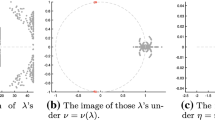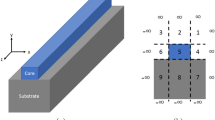Abstract
In this article, band structure calculations of two dimensional (2D) anisotropic photonic-crystal fibers (PhCFs) are considered. In 2D PhCFs, Maxwell’s equations for the transversal electric and magnetic mode become decoupled, but the difficulty, arising from the anisotropic permittivity \({{\varvec{\varepsilon }}}\) and/or permeability \({{\varvec{\mu }}},\) plaguing the frequency-domain finite difference method, especially the original Yee’s scheme, is our top concern. To resolve this difficulty, we re-establish the connection between the lowest order finite element method with the quasi-periodic condition and Yee’s scheme using 2D non-orthogonal mesh, whereby the decoupled Maxwell’s equations in 2D anisotropic PhCFs are readily discretized into a generalized eigenvalue problem (GEP). Moreover, we spell out the nullspace of the resulting GEP, if it exists, and explicitly construct the Moore–Penrose pseudoinverse of the singular coefficient matrix, whose smallest positive eigenvalues can be solved by the inverse Lanczos method. Extensive band structures of 2D PhCFs are calculated and benchmarked against reliable results to demonstrate the accuracy and efficiency of our method.








Similar content being viewed by others
Notes
We note that, in [2], the HPD \({{\varvec{\varepsilon }}}({{\textbf {r}}})\) may be discretized into a Hermitian positive semi-definite matrix as a result of (55a) there, which leads to severe difficulties in subsequent computations. In contrast, the HPD \({{\varvec{\varepsilon }}}({{\textbf {r}}})\) is guaranteed to be discretized into a HPD matrix if our (32d) is used instead.
Our MATLAB code for all examples in this section is available at https://github.com/FAME-GPU/2DPhC.
References
Joannopoulos, J.D., Johnson, S.G., Winn, J.N., Meade, R.D.: Photonic Crystals: Molding the Flow of Light. Princeton University Press, Princeton (2008). https://doi.org/10.2307/j.ctvcm4gz9
Chou, S.-H., Huang, T.-M., Li, T., Lin, J.-W., Lin, W.-W.: A finite element based fast eigensolver for three dimensional anisotropic photonic crystals. J. Comput. Phys. 386, 611–631 (2019). https://doi.org/10.1016/j.jcp.2019.02.029
Nédélec, J.-C.: Mixed finite elements in \({\mathbb{R} }^3\). Numer. Math. 35, 315–341 (1980). https://doi.org/10.1007/BF01396415
Nédélec, J.-C.: A new class of mixed finite elements in \({\mathbb{R} }^3\). Numer. Math. 50, 57–81 (1986). https://doi.org/10.1007/BF01389668
Taflove, A., Hagness, S.C.: Computational Electrodynamics: The Finite-Difference Time-Domain Method. Artech House, Boston (2005). https://doi.org/10.1016/B978-012170960-0/50046-3
Chern, R.-L., Hsieh, H.-E., Huang, T.-M., Lin, W.-W., Wang, W.: Singular value decompositions for single-curl operators in three-dimensional Maxwell’s equations for complex media. SIAM J. Matrix Anal. Appl. 36, 203–224 (2015). https://doi.org/10.1137/140958748
Huang, T.-M., Hsieh, H.-E., Lin, W.-W., Wang, W.: Eigendecomposition of the discrete double-curl operator with application to fast eigensolver for three dimensional photonic crystals. SIAM J. Matrix Anal. Appl. 34, 369–391 (2013). https://doi.org/10.1137/120872486
Huang, T.-M., Hsieh, H.-E., Lin, W.-W., Wang, W.: Matrix representation of the double-curl operator for simulating three dimensional photonic crystals. Math. Comput. Model. 58, 379–392 (2013). https://doi.org/10.1016/j.mcm.2012.11.008
Lyu, X.-L., Li, T., Lin, J.-W., Huang, T.-M., Lin, W.-W., Tian, H.: Solving Maxwell eigenvalue problems for three dimensional isotropic photonic crystals with fourteen Bravais lattices. J. Comput. Appl. Math. 410, 114220 (2022). https://doi.org/10.1016/j.cam.2022.114220
Ho, K.M., Chan, C.-T., Soukoulis, C.M.: Existence of a photonic gap in periodic dielectric structures. Phys. Rev. Lett. 65(25), 3152 (1990). https://doi.org/10.1103/PhysRevLett.65.3152
Johnson, S.G., Joannopoulos, J.D.: Block-iterative frequency-domain methods for Maxwell’s equations in a planewave basis. Opt. Express 8(3), 173–190 (2001). https://doi.org/10.1364/OE.8.000173
Sakoda, K.: Optical Properties of Photonic Crystals. Springer, Heidelberg (2004). https://doi.org/10.1007/b138376
Gupta, B.C., Kuo, C.-H., Ye, Z.: Propagation inhibition and localization of electromagnetic waves in two-dimensional random dielectric systems. Phys. Rev. E 69(6), 066615 (2004). https://doi.org/10.1103/PhysRevE.69.066615
Twersky, V.: Multiple scattering of radiation by an arbitrary configuration of parallel cylinders. J. Acoust. Soc. Am. 24(1), 42–46 (1952). https://doi.org/10.1063/1.1702220
Guo, S., Wu, F., Albin, S., Rogowski, R.S.: Photonic band gap analysis using finite-difference frequency-domain method. Opt. Express 12, 1741–1746 (2004). https://doi.org/10.1364/OPEX.12.001741
Rumpf, R.C., Garcia, C.R., Berry, E.A., Barton, J.H.: Finite-difference frequency-domain algorithm for modeling electromagnetic scattering from general anisotropic objects. Prog. Electromagn. Res. B 61, 55–67 (2014). https://doi.org/10.2528/PIERB14071606
Shen, L., He, S., Xiao, S.: A finite-difference eigenvalue algorithm for calculating the band structure of a photonic crystal. Comput. Phys. Commun. 143(3), 213–221 (2002). https://doi.org/10.1016/s0010-4655(01)00456-8
Dobson, D.C., Gopalakrishnan, J., Pasciak, J.E.: An efficient method for band structure calculations in 3D photonic crystals. J. Comput. Phys. 161, 668–679 (2000). https://doi.org/10.1006/jcph.2000.6521
Dobson, D.C., Pasciak, J.: Analysis for an algorithm for computing electromagnetic Bloch modes using Nédélec spaces. Comput. Methods Appl. Math. 1, 138–153 (2001). https://doi.org/10.2478/cmam-2001-0010
Jin, J.: The Finite Element Method in Electromagnetics. Wiley, New York (2002)
Lu, Z., Cesmelioglu, A., Van der Vegt, J.J.W., Xu, Y.: Discontinuous Galerkin approximations for computing electromagnetic Bloch modes in photonic crystals. J. Sci. Comput. 70(2), 922–964 (2016). https://doi.org/10.1007/s10915-016-0270-1
Liu, N., Tobón, L.E., Zhao, Y., Tang, Y., Liu, Q.H.: Mixed spectral-element method for 3-D Maxwell’s eigenvalue problem. IEEE Trans. Microw Theory Tech. 63, 317–325 (2015). https://doi.org/10.1109/TMTT.2014.2387839
Luo, M., Liu, Q.H.: Spectral element method for band structures of three-dimensional anisotropic photonic crystals. Phys. Rev. E 80, 056702 (2009). https://doi.org/10.1103/PhysRevE.80.056702
Li, F.-L., Wang, Y.-S., Zhang, C.: Boundary element method for bandgap computation of photonic crystals. Opt. Commun. 285(5), 527–532 (2012). https://doi.org/10.1016/j.optcom.2011.11.029
MATLAB: Version 9.8.0 (R2020a). The MathWorks Inc., Natick, Massachusetts (2020). http://www.mathworks.com
Huang, W.-Q., Lin, W.-W., Lu, H.H.-S., Yau, S.-T.: iSIRA: Integrated shift-invert residual Arnoldi method for graph Laplacian matrices from big data. J. Comput. Appl. Math. 346, 518–531 (2019). https://doi.org/10.1016/j.cam.2018.07.031
COMSOL Multiphysics® v 5.5.0. COMSOL Inc., Stockholm, Sweden (2020). http://www.comsol.com
Kittel, C.: Introduction to Solid State Physics. Wiley, New York (2004)
D’haeseleer, W.D., Hitchon, W.N.G., Callen, J.D., Shohet, J.L.: Flux Coordinates and Magnetic Field Structure. Springer, Berlin (1991). https://doi.org/10.1007/978-3-642-75595-8
Acknowledgements
T. Li was partially supported by the National Natural Science Foundation of China (NSFC) no. 12371377 and the Big Data Computing Center in Southeast University. H. Tian sincerely thanks the hospitality of Nanjing Center for Applied Mathematics (NCAM) during the initialization of this work.
Author information
Authors and Affiliations
Corresponding author
Ethics declarations
Conflict of interest
The authors declare no competing interests.
Additional information
Publisher's Note
Springer Nature remains neutral with regard to jurisdictional claims in published maps and institutional affiliations.
Appendices
Appendix A: Derivation of (7)
Using vector calculus identities, we have
For convenience, denote \(\vec {{{\textbf {v}}}}:={\varvec{\mu }}^{-1}\cdot (\vec {{\textbf {e}}}_z\times \nabla E_z).\) After projecting both sides of (3a) onto \(\vec {{\textbf {e}}}_z,\) we obtain
for the RHS and LHS of (3a), respectively.
Remember that \(E_z\) is a function of \({{\textbf {r}}}_{\perp },\) hence \(\nabla E_z\) should be understood as \([\nabla _{\perp } E_z, 0],\) then \(\vec {{\textbf {e}}}_z\times \nabla E_z\) is just \(\nabla _{\perp } E_z\) rotated counterclockwise by \(\pi /2\) within the plane perpendicular to \(\vec {{\textbf {e}}}_z\) and represented by \([\vec {{\textbf {e}}}_z\times \nabla _{\perp } E_z,0].\) Furthermore, by (4), \(\vec {{{\textbf {v}}}}\) should be understood as \([{\varvec{\mu }}_{\perp }^{-1}\cdot (\vec {{\textbf {e}}}_z\times \nabla _{\perp } E_z),0]\) with \(\vec {{\textbf {e}}}_z\times \vec {{{\textbf {v}}}}\) being understood similarly to \(\vec {{\textbf {e}}}_z\times \nabla E_z,\) therefore \(\nabla \cdot (\vec {{\textbf {e}}}_z\times \vec {{{\textbf {v}}}})\) should be seen as \(\nabla _{\perp }\cdot (\vec {{\textbf {e}}}_z\times \vec {{{\textbf {v}}}})+0.\) Thus, after using the definition of \(\vec {{{\textbf {v}}}}\) above, we obtain exactly the LHS of (7a).
Appendix B: Derivation of (28c)
With \(\varvec{a}_1\) and \(\varvec{a}_2\) as basis vectors of \({\varvec{\Omega }}\) shown in (15a), we can define the reciprocal vectors \(\varvec{a}^1\) and \(\varvec{a}^2\) such that \(\varvec{a}^\ell \cdot \varvec{a}_{\ell '} = \delta _{\ell ',\ell }, \ell ',\ell =1,2,\) or \([\varvec{a}^1,\varvec{a}^2][\varvec{a}_1, \varvec{a}_2]^{\top } = I_2\) in terms of matrix language. Then, given the basis function \(\phi _{ij}, i\in {\mathbb {N}}_1,j\in {\mathbb {N}}_2,\) it follows from [29] that
Furthermore, it follows from (15b) and [29] that
Rights and permissions
Springer Nature or its licensor (e.g. a society or other partner) holds exclusive rights to this article under a publishing agreement with the author(s) or other rightsholder(s); author self-archiving of the accepted manuscript version of this article is solely governed by the terms of such publishing agreement and applicable law.
About this article
Cite this article
Liu, Q., Yang, HN., Li, T. et al. An efficient and unified method for band structure calculations of 2D anisotropic photonic-crystal fibers. Calcolo 61, 20 (2024). https://doi.org/10.1007/s10092-024-00572-6
Received:
Revised:
Accepted:
Published:
DOI: https://doi.org/10.1007/s10092-024-00572-6




